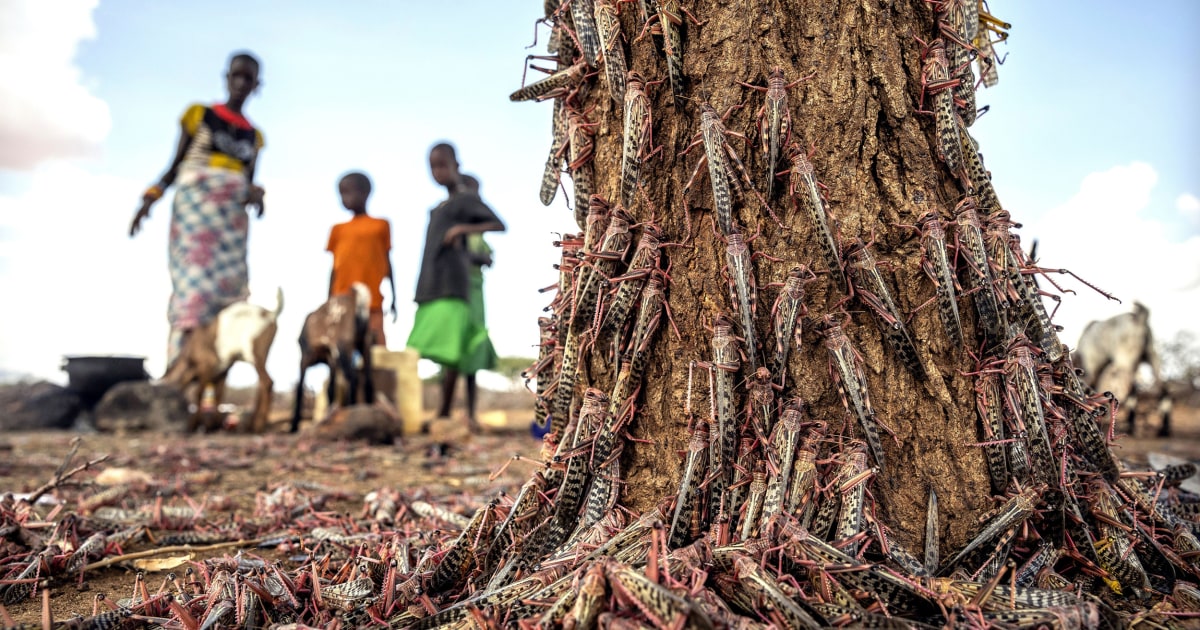hobie
Well-known member
- Joined
- Aug 9, 2019
- Messages
- 492
- Gender
- Male
- Religious Affiliation
- Seventh Day Adventist
- Political Affiliation
- Conservative
- Marital Status
- Married
(My original post in January)
This is a interesting development...
"The UN has called for international help to fight huge swarms of desert locusts sweeping through east Africa.
A spokesman for the UN's Food and Agricultural Organisation (FAO), called for aid to "avert any threats to food security, livelihoods, malnutrition".
Ethiopia, Kenya and Somalia are all struggling with "unprecedented" and "devastating" swarms of the food-devouring insects, the FAO has said.
The agency fears locust numbers could grow 500 times by June.
Ethiopia and Somalia have not faced an infestation on this scale for 25 years, while Kenya has not seen a locust threat this size for 70 years, the FAO said earlier this week. South Sudan and Uganda are also at risk if the swarms continue to grow and spread." Massive locust swarms spark UN appeal for help
"Swarms of locusts in east Africa have devastated crops and sent a passenger plane off course, and now the UN is warning that without international intervention the voracious insects threaten the food security of tens of millions of people." ‘Unprecedented’ Swarms of Locusts Are Devouring Crops and Slamming Into Planes in East Africa
and the updates as they spread....
Looks like the locust have spread to the Middle East, as it has hit Iran..
"Iran afflicted by large swarms of desert locusts, amid coronavirus woes
'The density of locusts in the swarms is so high that a 10 to 15-centimeter layer of dead locusts forms on the ground after spraying pesticides.'..
Iran afflicted by large swarms of desert locusts, amid coronavirus woes
It looks like its spreading even more than just the Middle East...
"In East Africa, the Middle East and South Asia, traveling swarms of locusts the size of Manhattan are putting potentially hundreds of millions at risk of starvation in what the UN has called the worst outbreak in a quarter of a century.
What it means: "Millions will starve because clouds of approximately 80 million desert locusts per square kilometer are voracious," writes Robert Rotberg, founding director of the Harvard Kennedy School’s Program on Intrastate Conflict.
"In one day they consume wheat, barley, sorghum, or maize crops that feed 35,000 people. Masses the size of cities can consume 1.8 million metric tons of vegetation every day – enough to feed 81 million people."
"The United Nations is to test drones equipped with mapping sensors and atomizers to spray pesticides in parts of east Africa battling an invasion of desert locusts that are ravaging crops and exacerbating a hunger crisis."
The world's other plague: Locust swarms put millions at risk of starvation across Africa and Asia
here is latest video of it...
'They've Eaten Everything': Locust Swarms Destroy Harvests In Pakistan
This is a interesting development...
"The UN has called for international help to fight huge swarms of desert locusts sweeping through east Africa.
A spokesman for the UN's Food and Agricultural Organisation (FAO), called for aid to "avert any threats to food security, livelihoods, malnutrition".
Ethiopia, Kenya and Somalia are all struggling with "unprecedented" and "devastating" swarms of the food-devouring insects, the FAO has said.
The agency fears locust numbers could grow 500 times by June.
Ethiopia and Somalia have not faced an infestation on this scale for 25 years, while Kenya has not seen a locust threat this size for 70 years, the FAO said earlier this week. South Sudan and Uganda are also at risk if the swarms continue to grow and spread." Massive locust swarms spark UN appeal for help
"Swarms of locusts in east Africa have devastated crops and sent a passenger plane off course, and now the UN is warning that without international intervention the voracious insects threaten the food security of tens of millions of people." ‘Unprecedented’ Swarms of Locusts Are Devouring Crops and Slamming Into Planes in East Africa
and the updates as they spread....
Looks like the locust have spread to the Middle East, as it has hit Iran..
"Iran afflicted by large swarms of desert locusts, amid coronavirus woes
'The density of locusts in the swarms is so high that a 10 to 15-centimeter layer of dead locusts forms on the ground after spraying pesticides.'..
Iran afflicted by large swarms of desert locusts, amid coronavirus woes
It looks like its spreading even more than just the Middle East...
"In East Africa, the Middle East and South Asia, traveling swarms of locusts the size of Manhattan are putting potentially hundreds of millions at risk of starvation in what the UN has called the worst outbreak in a quarter of a century.
What it means: "Millions will starve because clouds of approximately 80 million desert locusts per square kilometer are voracious," writes Robert Rotberg, founding director of the Harvard Kennedy School’s Program on Intrastate Conflict.
"In one day they consume wheat, barley, sorghum, or maize crops that feed 35,000 people. Masses the size of cities can consume 1.8 million metric tons of vegetation every day – enough to feed 81 million people."
"The United Nations is to test drones equipped with mapping sensors and atomizers to spray pesticides in parts of east Africa battling an invasion of desert locusts that are ravaging crops and exacerbating a hunger crisis."
The world's other plague: Locust swarms put millions at risk of starvation across Africa and Asia
here is latest video of it...
'They've Eaten Everything': Locust Swarms Destroy Harvests In Pakistan
Last edited:

